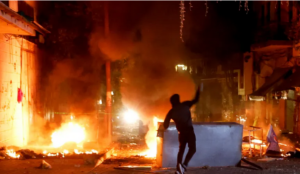IDF destroys terrorist’s home in West Bank, injures two photojournalists with rubber bullets.

A Palestinian throws stones as the Israeli army raids Ramallah, 8 June 2023
Yaniv Kubovich, Jack Khoury and Reuters report on 8 June 2023:
The Israeli military demolished the Ramallah home of Asalam Faroukh overnight on Wednesday, the 26-year-old suspected of carrying out a twin bombing attack in Jerusalem in November, wounding at least six other Palestinians.
During the raid, the Israeli military fired live bullets and tear gas at groups of residents hurling stones and setting trash bins on fire, eyewitnesses said. According to the Palestinian Health Ministry, at least six people were rushed to hospitals for treatment, including three who sustained gunshot wounds.
Medical officials from a hospital in Ramallah said that two press photographers for different Arab media sites were hit by rubber bullets. One arrived at the hospital in serious condition with a head injury and is now stable, and the other was lightly wounded by a bullet to the stomach.
The IDF spokesperson confirmed that forces used crowd dispersal measures and live fire, “resulting in injuries but no casualties among our forces.” The High Court had earlier rejected an appeal against the demolition, the statement added.
In a separate statement, the IDF spokesperson also confirmed that it has “been determined” that a Palestinian photojournalist present in the vicinity sustained injuries, “likely caused by a rubber bullet,” and that the “circumstances of the incident are currently being reviewed.”
The IDF said it makes “extensive efforts” to minimize harm to individuals not involved and that it “prioritizes the principles of freedom of movement and press.”
Palestinian Prime Minister Mohammad Shtayyeh visited on Thursday the demolished house and said that “they would rebuild every house destroyed by the occupation” and provide assistance to the affected families. Shtayyeh added that the demolition is “a criminal act” and “a form of collective punishment imposed by Israel on the Palestinian population.”
Faroukh is suspected of remotely detonating explosives at two different Jerusalem bus stops in November, killing two people and injuring more than 20.
Israeli security authorities arrested Faroukh, a mechanical engineer with no criminal record who taught himself how to build explosives, in the wake of the attack. According to investigators, Faroukh has an Israeli identity card and comes from an established family of five children which owns a family business.
According to the investigation by the Shin Bet and the Jerusalem District Attorney, the suspect allegedly identified with the Islamic State, and learned to build explosives online from household materials and how to cover his tracks and identity. For this purpose, he dug a pit in the area of Beitunia in the West Bank where he conducted experiments in the construction of explosive charges. Investigators found raw materials hidden to create additional charges in the pit, and a Carlo type weapon was also seized in the possession of the perpetrator.
Faroukh learned how to build an explosive device online from household materials and how to cover his tracks and identity. For this purpose, he dug a pit in the area of Beitunia in the West Bank where he conducted experiments in the construction of explosive charges. Investigators found raw materials hidden to create additional charges in the pit, and a Carlo type weapon was also seized in the possession of the perpetrator.
Faroukh planned to carry out three attacks at the same time, a joint statement from the Shin Bet and Israeli police said. He observed the area at the exit of Jerusalem and studied the rush hour period, as well as the bus station at the Ramot intersection.
His attacks killed 15-year-old Yeshiva student Aryeh Shechopek and Tedsa Tashuma, who was in his fifties and died of his wounds.
The explosive charges were disguised in a sophisticated way – one charge was placed behind bushes at a hitchhiking station, and the second charge at the Ramot station was hidden under wood that he had cut in advance.
On the morning of the attacks, the suspect placed the charges an hour before they exploded, and rode away on a scooter. The third charge contained around five kilos of explosives, which he planned to connect to a gas charge. However, due to a technical malfunction in the cell phone used to detonate the charge, he gave up on activating it. He then fled on a scooter towards the area of Ma’ale Adumim in Jerusalem, where he was eventually captured.
For two days after the attack, a military unit searched the area, leading them to the scooter Faroukh used to flee the scene. The next day, police found hidden items of clothing, a helmet and several more charges buried in the ground and under rocks. Although Faroukh attempted to cover his tracks by defacing the scooter’s serial number and painting over it, he was eventually captured at his place of work in Jerusalem.
This article is reproduced in its entirety
